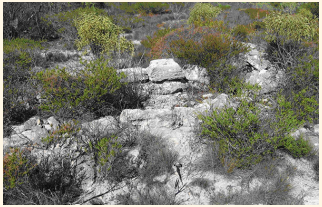18.2: Trailblazer
- Page ID
- 142434
Multimodal Trailblazer: Torika Bolatagici

"I can never deny the deeply personal
place that the work comes from."
Figure \(18.7\) Torika Bolatagici (https://openstax.org/r/4S3YIw-PFAs) works to bring attention to indigenous artists. Speculation exists as to the origin of this wall- like stone structure; some believe it was constructed by early peoples of Australia. (credit: “Man-made stone wall” by Rupert Gerritsen/Wikimedia Commons, CC0).
By the end of this section, you will be able to:
- Identify various rhetorical and culture contexts while reading for inquiry, learning, critical thinking, and communication.
- Demonstrate that genre conventions vary and are shaped by purpose, culture, and expectation.
Digital Representations of Embodiment and Cultural Identity
Torika Bolatagici is a creator, educator, and art historian who works with various modalities, including photography (https://openstax.org/r/photography), video, fine art, and mixed media (https://openstax.org/r/ mixed_media). Bolatagici was born in Tasmania and, as a young person, spent time living in Hobart, Tasmania; Sydney, Australia; and her father’s village of Suvavou, Fiji. Her work has been featured across the globe, including in exhibits in the United States, Taiwan, and Mexico as well as throughout New Zealand and Australia. She has a PhD from the School of Art and Design, University of New South Wales, where she wrote her dissertation on “Somatic Sotia: Commodity, Agency and the Fijian Military Body.”
In 2013 and 2014, Bolatagici coordinated the Contemporary Pacific Arts Festival (https://openstax.org/r/ contemporary_specific), curating an experience that focused on Pacific arts practices in Australia. She invited speakers to present on themes spanning activism and the arts, cultural appropriation, and contemporary artistic practices. Bolatagici now works as an educator, lecturing on art and performance at Deakin University in Australia, and has led youth arts workshops in the local Pacific community.
Reflecting on the beginnings of her career, she describes going through her undergraduate coursework and feeling the responsibility of bringing “brown-ness” to the classroom. After finding that higher education largely dismissed the lived experiences of marginalized communities and spending time at the Stuart Hall Library at the Institute of International Visual Arts, Bolatagici was inspired to create the pop-up Community Reading Room in Melbourne, Australia, in 2013.
Through the pop-up room, she hoped to engage the community in international visual arts and culture. She began her initiative by sharing her own personal collection, including texts and anthologies of BIPOC (Black, Indigenous, and people of color) art. The Community Reading Room provides an emphasis on contemporary art and theory from Africa, the Americas, and Oceania.
Bolatagici has incorporated a variety of media (https://openstax.org/r/variety) into her academic and professional portfolios, describing how her work helps her not only represent diverse cultures (https://openstax.org/r/represent) but also explore her own identity. From photo essays (https://openstax.org/r/ photo_essays) to academic papers, her compositions are anchored by the common thread of representing marginalized people and experiences, particularly those related to communities of color. Her creative output has focused on representation of mixed-race identity, Pacific arts practices, and militarism. Through mixed media, she investigates relationships between visual culture and historiography (study of historical writings); human ecology (study of relationships between humans and their natural, social, and created environments); and the intersection of gender, knowledge, and globalization.
Bolatagici describes her work as interdisciplinary, creating components across a wide range of media. Instead of limiting herself, she allows her work to flow naturally, staying focused in the moment. With these unique components, she looks at the relationship between visual culture and human ecology. This interdisciplinary approached emerged for Bolatagici even before she knew it as multimodalism. Because her interests in college varied so greatly, she pursued a media arts degree so that she could explore visual arts as they related to cultural studies. This pursuit grew into a career that now includes new modes and media sources, such as photography, video, and mixed media.
Choosing a multimodal approach because it better communicates the complex subjects she conveys, Bolatagici draws on her own experiences in order to represent the experiences of marginalized people at the forefront of her compositions. For Bolatagici, creating in any form is bigger than the page, and she aims to bring her reality to life through visual, textual, and multimedia creations that communicate in four dimensions.
Read Bolatagici’s weekly journal (https://openstax.org/r/freshmilk) during her residency in Barbados.
Discussion Questions
- How does using a multimodal approach allow Bolatagici to communicate her lived experience?
- Why does representation matter in multimodal composition? How has Bolatagici addressed this in her methods?
- What role can multimodal compositions play in exploring experiences beyond your own?
- How can multimodal works at times better communicate aspects of culture and history than literary text alone?
- In what sense is bringing communities together an important aspect of Bolatagici’s work?


